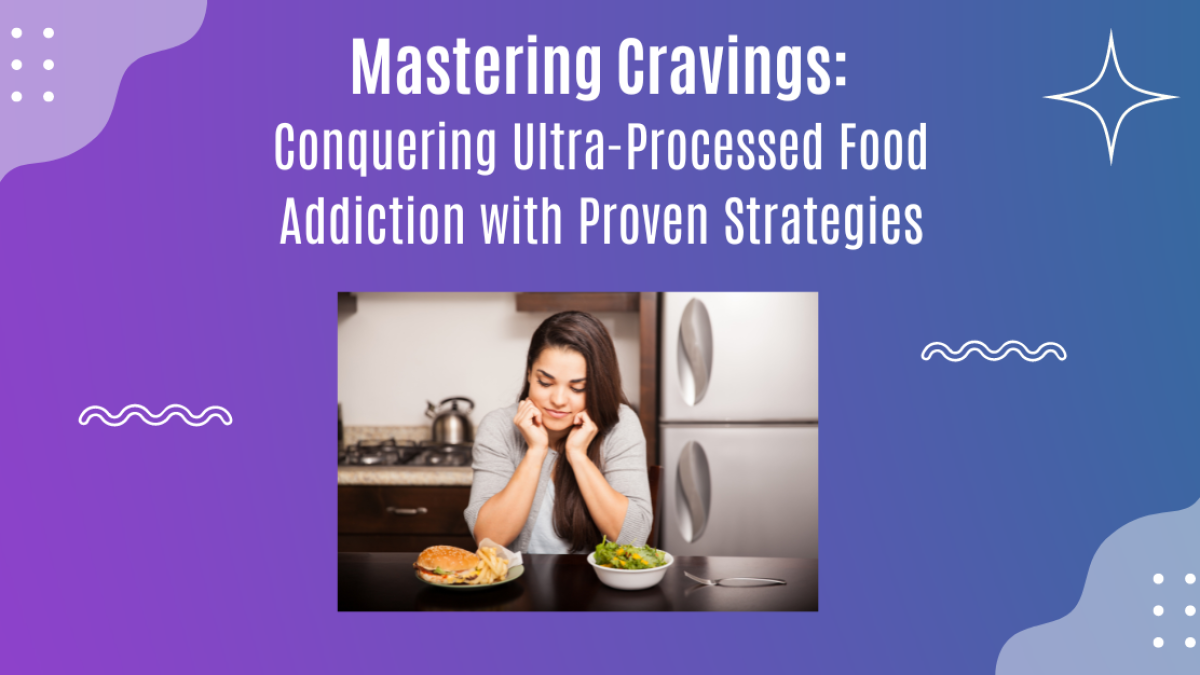Mastering Cravings: Conquering Ultra-Processed Food Addiction with Proven Strategies

Discover how to recognize and overcome cravings in ultra-processed food addiction with practical strategies for taking control of your eating habits.
Understanding Cravings in Ultra-Processed Food Addiction: Symptoms and Strategies to Overcome Them
Cravings are a shared experience, but when it comes to Ultra-Processed Food Addiction, they can feel overwhelming and challenging to manage. These cravings often drive people to consume more of these unhealthy foods despite knowing the negative impact on their health. In this blog, we’ll explore what cravings in Ultra-Processed Food Addiction look like, the symptoms associated with them, and practical strategies to overcome them.
What Are Cravings in Ultra-Processed Food Addiction?
Cravings are intense desires or urges to eat specific foods, particularly those highly processed and engineered to be irresistibly tasty. In the context of Ultra-Processed Food Addiction, cravings go beyond mere hunger; they can become powerful compulsions that are difficult to ignore or control. These cravings often occur even when you’re not physically hungry and can be triggered by various factors, including emotions, stress, and environmental cues.
Symptoms of Cravings in Ultra-Processed Food Addiction
Recognizing the symptoms of cravings can help you understand when you’re experiencing them and take steps to manage them effectively. Common symptoms include:
1. Intense Focus on Specific Foods: You may obsessively think about certain ultra-processed foods, like chips, cookies, or sugary snacks, to the point where it’s difficult to concentrate on anything else.
2. Emotional Eating: Cravings often arise in response to emotions like stress, boredom, loneliness, or sadness. You may turn to ultra-processed foods to comfort yourself or escape from these feelings.
3. Physical Sensations: Cravings can manifest as physical sensations, such as a dry mouth, stomach rumbling, or even a headache, making the urge to eat even more compelling.
4. Loss of Control: When experiencing cravings, you might feel a loss of control over your eating habits. This can lead to devouring large quantities of ultra-processed foods, often followed by feelings of guilt or regret.
5. Mindless Eating: Cravings can lead to mindless eating, where you consume ultra-processed foods without fully being aware of how much you eat or even enjoy the taste.
How to Overcome Cravings in Ultra-Processed Food Addiction
While cravings can be powerful, they’re not impossible to overcome. Here are some strategies to help you manage and reduce cravings:
1. Identify Triggers: Identify the triggers that lead to your cravings. These could be certain emotions, situations, places, people, or even specific times of the day. Once you know your triggers, you can avoid or address them.
2. Mindful Eating: Practice mindful eating by focusing on your food and eating experience. This means slowing down, savoring each bite, and tuning into your body’s hunger and fullness cues. Mindful eating can help you distinguish between actual hunger and cravings driven by emotions or habits.
3. Healthy Substitutes: When a craving strikes, try substituting the ultra-processed food with a less risky option. For example, if you’re craving something sweet, reach for a piece of fruit instead of candy. Over time, your taste preferences may shift towards lower-exposure foods.
4. Distraction Techniques: Cravings usually pass within 15-20 minutes. During this time, distract yourself with a different activity. Go for a walk, call a friend, or engage in a hobby you enjoy. By redirecting your attention, you can reduce the intensity of the craving.
5. Stay Hydrated: Sometimes, thirst can be mistaken for hunger or cravings. Make sure you’re drinking enough water throughout the day, and when a craving hits, try drinking a glass of water first to see if it helps.
6. Regular Meals: Eating balanced meals at regular intervals can help stabilize your blood sugar levels and reduce the likelihood of cravings. Include a mix of protein, healthy fats, and fiber in your meals to keep you satisfied for longer.
7. Seek Support: Don’t hesitate to seek support from friends, family, or a professional. Talking about your cravings and getting encouragement from others can make it easier to manage them. Joining a support group, like 12 Step groups or other peer support groups (free of charge), or a membership like Sweet Sobriety for food addiction can also provide valuable insights and coping strategies.
8. Address Emotional Needs: If your cravings are often tied to emotional eating, finding alternative ways to address your emotional needs is essential. This could include practicing relaxation techniques like deep breathing, engaging in physical activity, or exploring creative outlets like journaling or art.
Conclusion
Cravings are a natural part of Ultra-Processed Food Addiction, but they don’t have to control your life. By recognizing the symptoms and implementing strategies to manage them, you can take significant steps toward overcoming your addiction and improving your overall health. Remember, progress may be gradual, and setbacks can happen, but with persistence and support, you can regain control over your eating habits and break free from the cycle of cravings.
Categories: : Carb Addiction, Cravings, Food Addiction, Recovery, Sugar Addiction, Ultra-Processed Food Addiction
 Molly Painschab
Molly Painschab 